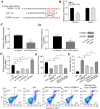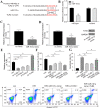Astragaloside IV protects human cardiomyocytes from hypoxia/reoxygenation injury by regulating miR-101a
- PMID: 32394311
- PMCID: PMC7272390
- DOI: 10.1007/s11010-020-03743-5
Astragaloside IV protects human cardiomyocytes from hypoxia/reoxygenation injury by regulating miR-101a
Abstract
Astragaloside IV (AS/IV) is one of the extracted components from the traditional Chinese medicine Astragalus which has been demonstrated to have potential capacity for anti-inflammation activity and for treating cardiovascular disease. Our purpose was to determine the function and underlying molecular mechanism of AS/IV in hypoxia/reoxygenation (H/R) injured in cardiomyocytes. Differentially expressed genes (DEGs) were screened using bioinformatic analysis, and the molecular targeting relationship was verified by the dual-luciferase report system. H/R injured cardiomyocytes were employed to explore the effect of AS/IV. QRT-PCR and Western blot analysis were applied to detect the expression of mRNA and proteins, respectively. Additionally, superoxide dismutase (SOD), lactic dehydrogenase (LDH) and MDA (malondialdehyde) levels were detected to determine the oxidative damage. Cell viability was assessed by CCK-8, and flow cytometry was used to evaluate cell apoptosis ratio. TGFBR1 and TLR2 were selected as DEGs. Additionally, AS/IV could enhance cell proliferation and upregulated miR-101a expression, which suppressed TGFBR1 and TLR2 expression in H/R injured cardiomyocytes. Moreover, the results of Western blot exhibited that the downstream genes (p-ERK and p-p38) in the MAPK signaling pathway were suppressed, which meant AS/IV could inhibit this pathway in H/R injured cardiomyocytes. Overall, this study demonstrated AS/IV could attenuate H/R injury in human cardiomyocytes via the miR-101a/TGFBR1/TLR2/MAPK signaling pathway axis, which means that it could serve as a possible alternate for H/R treatment.
Keywords: Astragaloside IV; Hypoxia/reoxygenation injury; MAPK signaling pathway; MiR-101a.
Conflict of interest statement
The authors declare that they have no conflict of interest.
Figures





References
-
- Dyson A, Dal-Pizzol F, Sabbatini G, Lach AB, Galfo F, Dos Santos CJ, Pescador Mendonca B, Hargreaves I, Bollen Pinto B, Bromage DI, Martin JF, Moore KP, Feelisch M, Singer M. Ammonium tetrathiomolybdate following ischemia/reperfusion injury: chemistry, pharmacology, and impact of a new class of sulfide donor in preclinical injury models. PLoS Med. 2017;14:e1002310. doi: 10.1371/journal.pmed.1002310. - DOI - PMC - PubMed
MeSH terms
Substances
LinkOut - more resources
Full Text Sources
Research Materials
Miscellaneous

